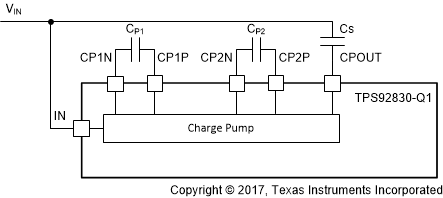JAJSE12A October 2017 – October 2017 TPS92830-Q1
PRODUCTION DATA.
- 1 特長
- 2 アプリケーション
- 3 概要
- 4 改訂履歴
- 5 概要(続き)
- 6 Pin Configuration and Functions
- 7 Specifications
- 8 Detailed Description
- 9 Application and Implementation
- 10Layout
- 11デバイスおよびドキュメントのサポート
- 12メカニカル、パッケージ、および注文情報
パッケージ・オプション
メカニカル・データ(パッケージ|ピン)
- PW|28
サーマルパッド・メカニカル・データ
- PW|28
発注情報
8.3.2.1 Charge Pump Architecture
The TPS92830-Q1 device uses a two-stage charge pump to generate the high-side gate-drive voltage. The charge pump is a voltage tripler using external flying and storage capacitors.
CP1 is the first-stage flying capacitor, connected between CP1P and CP1N, which are the positive and negative nodes, respectively. CP2 is the second-stage flying capacitor, connected between CP2P and CP2N, which are the positive and negative nodes, respectively. CS is the storage capacitor, connected between CPOUT and IN. CS stores charge for the high-side gate driver.
The charge pump switches at frequency f(cp_sw) to optimize EMI performance.
Negative nodes CP1N and CP2N are driven by a 5-V driver, thus the maximum voltage on charge-pump output node CPOUT is approximately V(IN) + V(CP_drv). The charge pump voltage across storage capacitor CS is not dependent on V(IN).
 Figure 20. Charge Pump
Figure 20. Charge Pump